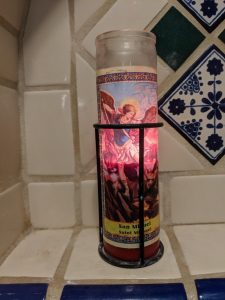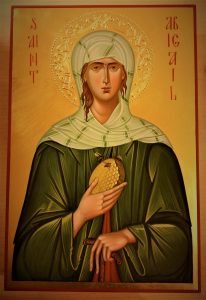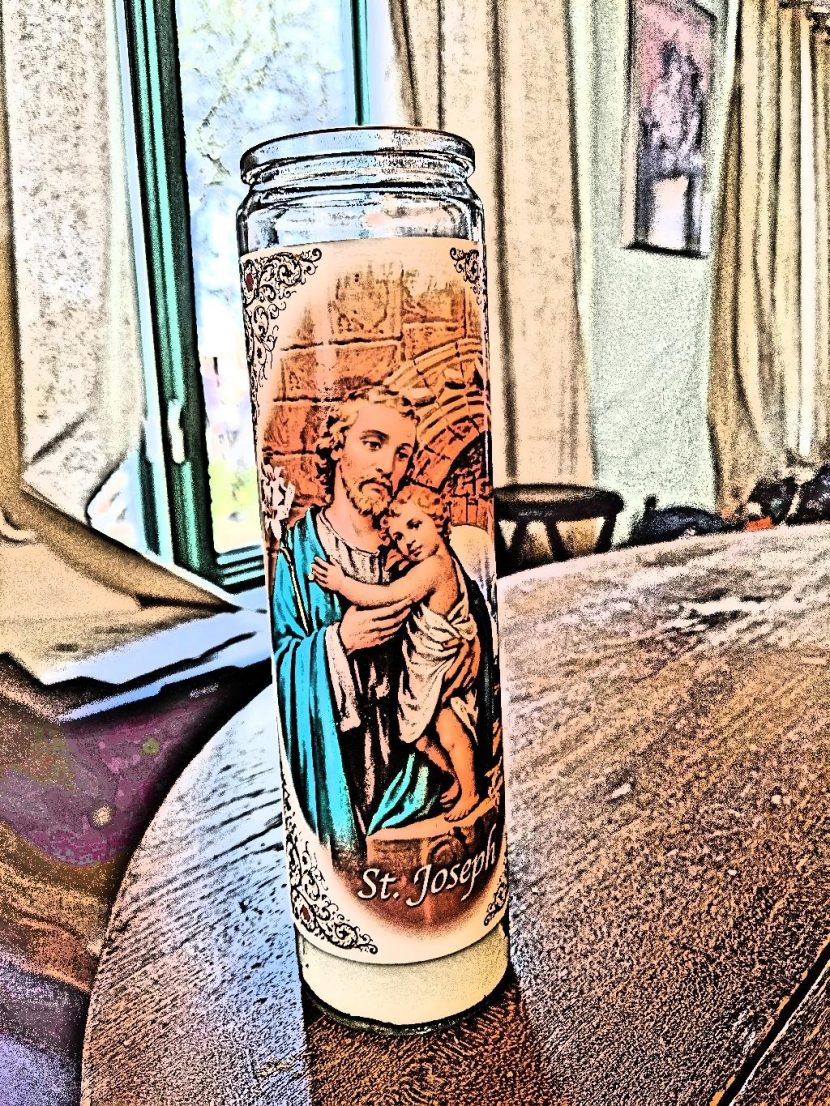You may have seen rows of them in grocery, drug stores, discount, and big-box stores alike.
They usually have an attractive drawing on them. The ones found in the United States are often dedicated to the Sacred Heart of Jesus, the Virgin Mary, St. Michael, St. Joseph, or another sacred concept, and are mostly sold to members of the Catholic Church, devout or otherwise.
When times are tough, they’re especially good sellers. In March 2020, when the coronavirus started becoming more frequent in the United States, I noticed that their price rose over 150 percent at one big-box store after churches closed.
It was understandable. Pandemics scare people. Thoughts of losing income and dying interfere with sleep. Living through a pandemic is stressful. Prayer candles can help one find mental solace before bed. One needs all of the blessings he or she can get!
Turning your overwhelming problems over to a higher power can be comforting at any time.
Other than light one and use it to illuminate an area, what can you do with one of them? Why would you want to have one of these lit as opposed to another candle?
Read on. I’ll tell you. I’ll also show you how you can make your own.
Why light a prayer candle
Prayer is an age-old way of dealing with stress and focusing thoughts.
Prayer candles and other images are a way of focusing thoughts. You’re not praying to the image. It’s a spiritual tool.
Prayer candles are beautiful, especially when lit and especially in darkness or dim light. They put forth a pleasant, contemplative light.
There are prayer candles that don’t use a flame but rather a small incandescent or LED light. That’s possibly safer if you’re going to leave the fire unattended or fall asleep while the candle is still burning. Many people probably think that glass or plastic lights aren’t as pleasant as flames, however. Glass or plastic lights aren’t as natural as fire.
The really small candles are known as votive candles. You’ll often see a whole rack of lit and unlit votive candles in a Catholic church in front of an image or statue of the Virgin Mary or another saint.
There’s nothing new about humans finding solace and comfort around a fire. People have been doing it for as long as there have been humans.
At its root, the flame or the light serves as a visual cue to relax and reflex.
When you light your prayer candle before bed, blow it out before you get tired.
If you find yourself enjoying the light and the image, at least put it up and away where it’s safe and it’s unlikely to get knocked over.
Get into a contemplative mindset
I find this to be an excellent way to get into a relaxed, contemplative mindset:
Focus on the visual cue that the prayer candle provides. Close your eyes and pause.
Breathe in for a count of four.
Hold your breath for four more seconds.
Then, exhale for four seconds.
Wait for four more seconds before you start breathing in again.
By pausing like that, you’re compounding the effect of the visual cue and the physical cues of controlled breathing.
Remember that exercise. It’s useful for settling the fight or flight response down and maintaining calm under adverse circumstances.
Prayer candle vs. regular candle
Sure, you could do this with a regular candle. What’s so special about a prayer candle?
If you’re from a more secular background or even from certain religious backgrounds, this may make you feel silly and superstitious. If you come from another tradition, why would you want to adopt it into yours?
Feelings like those might be a whole lot to resolve for some people. At its root, using a prayer candle is a way of actively modeling good behavior. The mind follows the body and vice versa.
You’ve noted personal characteristics and qualities you’d like to adopt. You ponder them and apply them to your own life and situation. You interact with the idea of the personal characteristics and qualities you’d like to adopt as represented by the individual or spirit you’re emulating.
It’s a mental exercise.
Yet sometimes miracles happen. They can often be explained away by coincidences or whatever, but not always. Humans are capable of all kinds of mental gymnastics. If you’re open-minded enough, you can see and appreciate a lot more about life than you can if you aren’t.
The conventional view of miracles is they’re based on mental belief, and there’s nothing miraculous happening. The conventional view of miracles is correct a lot of times. Is it correct all of the time? Does nothing miraculous ever happen? Many people say otherwise. You have to decide for yourself.
Contemplative prayer and creative visualization
Prayer isn’t entirely different from creative visualization. It’s a cousin.
In creative visualization, you’re defining the goal. You’re self-generating the feeling of what it would be like to achieve the goal. You’re working to believe you already have achieved the goal. You’re denying reality in the hope you can shape reality.
In this form of prayer with a prayer candle, on the other hand, you may be asking that something is granted to you. You may request that the saint or whoever prays to God so that you be given something, but not necessarily. You can be seeking a form of friendship with the saint. You’re contemplating the character and nature of the person or concept pictured on your candle and, perhaps, working to mentally adapt that into your character. A saint is a type of hero. Creative visualization is focused on a reality that doesn’t exist yet. Praying with a prayer candle is focused on a reality that has been in the past or does exist. You’re trying to create more of that type of reality in yourself.
Saints, because they were humans like us, can be viewed as more approachable than the Son of God. They’re flawed, like us. Admittedly, their flaws are often pretty mild. They’re a cut above us but not too far of a cut.
If your candle features a saint, you can ask for his or her assistance in petitioning God. The favor doesn’t come from the saint.
Focusing on the characteristics and challenges that a particular saint faced in his or her life is a good mindset to get into before sleep.
You can read about all kinds of saints online or, to avoid blue light, in books.

Prayer candle-mediated modeling
There are over 10,000 recognized saints. An exact number is impossible to know because several times groups of people were martyred, and few details are known of them except for their name. Sometimes, in the same group, several people with the same name were killed. It was hard to piece apart from the full, comprehensive information about everyone involved.
It may be a better choice to choose a saint that’s featured on a commercially made prayer candle, like St. Joseph.
If you were using a prayer candle to help you think about Joseph’s life, you might contemplate the way Joseph was able to follow his intuition to keep his family safe. You’d think about the way he was able to understand how Mary didn’t have relations with another man until after an angel explained what was going on. You’d think about how he worked as a simple carpenter. That shaped people’s perceptions of their son. You’ll ask and ponder what you consider to be attractive about the man, just like you might ask questions of a friend of yours.
Just as a living person can be a friend, so can a saint. Whether you consider the friendship to be imaginary or not is up to you. You’ll base your imagination upon what’s known about the real person, however. In that way, creative visualization is different.

Making a prayer candle
You can convert any candle. One way would be to draw your own picture and paste it on. Another would be finding an image online, printing it, and putting it on a candle.
For example, say that after doing some reading about various saints, you wanted to make one featuring St. Abigail. You’d look for an image of her online. If you can find a suitable picture on a prayer card or somewhere else, use that.
I think that the best image you could choose would feature reminders of his or her life. How are you going to know what someone who lived hundreds of years before photography looked?

Just as an example, take St. Abigail. She was born in the 6th century in Ireland. She had a family that fought each other frequently. She grew tired of it. She left home and went to live on an island, Inis Orr.
After some time, she was visited by an angel who told her that Inis Orr wasn’t to be her place of “resurrection.” God wanted her to be somewhere else. He’d say to her exactly where by sending a herd of nine white deer.
She went all over the southern coast of Ireland and saw the deer in Ballyvourney, County Cork.
She raised bees and used honey as medicine to help people out. She founded a convent, helped the sick, and dealt with a plague. She was known for being remarkably charitable.
So knowing this about her, what would she have been like as a person? In making your St. Abagail candle, you’d use those facts as a sort of springboard.
When choosing the image for your candle, try to pick one that has symbols featured from her life. For example, with St. Joseph, maybe select a drawing that features a baby Jesus and some kind of carpenter’s tools. For St. Abigail, you can perhaps choose one that has white deer and bees.
You can always draw your own, too.
It’s not honest to pretend anyone on Earth can know 100 percent for sure why anything works the way it does on our plane of existence. There are too many random variables. You go on for a while, and what you thought was 100 percent true is shown to be only partially that way. Having a skeptical mindset helps in many situations. Other situations are entirely out of our control.
The way the human mind deals with this is to shut out certain events. The “rational” people don’t know how to classify them in their minds. Or they’ll make up some explanation like calling the “Miracle of the Sun” a mass hallucination. As if mass hallucinations happen to 60,000 – 100,000 witnesses every day! Or that if the sun did dance in the sky a lot more than some people in Portugal would have noticed.
It’s hard to say, “I don’t know?” It’s easy to make up some explanation. Anyone can play that game.
An excellent example of this is an event that happened in a medium-sized town in Illinois in 2010.
In 2010, Bonnie Engstrom of Peoria, Illinois, gave birth to a son who was dead for 61 minutes before being revived. Probably even more surprising was that after that, the boy was utterly normal. The event had dozens of witnesses. It was credited as a miracle through the intercession of Archbishop Fulton J. Sheen.
Such miracles don’t get reported in mainstream news. People have a whole range of levels of belief about such episodes but don’t always know how to process stories like that. Nevertheless, they do happen.
They still happen. They’re reported, though not on the mainstream news. The “why” is beyond the scope of this article. Mainstream news should stick to the facts, and news consumers shouldn’t seek out self-confirmation all of the time.
Meditation, not magic
Using a prayer candle isn’t magic. Depending on your situation, it may not feel appropriate or right for you. Why it deserves discussion is that too often, we dance around ways of handling stress because our society is profoundly secular. And focusing on only secular tools is ridiculous.
One newsletter I get recommended three ways of handling stress: meditation, laughing, and talking to friends. Those aren’t bad suggestions, sometimes, but we need all the tools we can get.
Also on the blog:
James Cobb, RN, MSN, is an emergency department nurse, what’s known as a “cradle Catholic,” and the founder of the Dream Recovery System. His goal is to provide his readers with simple, actionable ways to improve their health and maximize their quality of life.
Parts of this website includes affiliate links for which we receive a small commission if something is purchased through the link.
